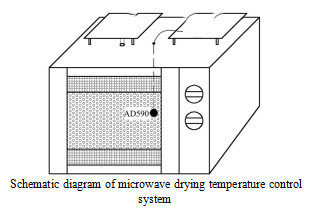Application relationship between wood and microwave drying
1.1.2 Good drying quality due to the increased permeability of microwave drying equipment, in the drying process, heating uniform, the water in the wood from the inside out at the same time, so that the expansion and shrinkage coefficient of wood is basically the same, so as to maximize the avoidance of wood in the drying process of deformation, cracking and other defects, and even drying. The residual stress is small. In addition, microwave drying of wood has selectivity and partial absorption with high moisture content.
The wave energy is much, and the amount of heat is also many, which is conducive to the consistency of wood moisture content.
1.1.3 can keep wood's original color and wood color change.
The higher the temperature, the longer the action time and the higher the moisture content, the faster the discoloration. Compared with conventional drying, the microwave drying cycle of wood is shortened by tens to hundreds of times, and each heating process is from low temperature to high temperature, so the residence time at high temperature is shorter. Thereforecro, microwave drying of wood hardly changes the original color and luster of wood.
1.1.4 insecticidal and sterilizing effect is good.
Kill all kinds of insect fungi thoroughly, eliminate insect pests of wood products, improve product strength and prolong service life.
1.1.5 equipment occupies space, suitable for pipeline production of microwave drying equipment, its host and auxiliary equipment is simple, small size, small footprint. Microwave drying process can realize automatic and continuous processing. It is suitable for production line and has high productivity.
1.1.6 can directly dry wood semi-finished wood by microwave drying.
The biggest feature is the semi-finished products that can dry wood products. Usually, wood products are made by drying the wood before using, such as cutting the material to make a shape and then drying, forming wood in the drying process slightly cracking, deformation, can not be used. And the wood made by microwave direct drying is not deformed, cracked and damaged, so wool can be made into various shapes of semi-finished products according to the needs of wood structure, and then dried in microwave oven. In general, the utilization ratio of wool in wood products production is about 60. After semi-finished products are made, drying energy can be saved.
1.2 application and research of microwave drying
In the 1970s, scholars in the United States, Japan and other countries carried out research on microwave drying of wood, and made microwave dryers suitable for wood drying. Patents on wood microwave drying methods and equipment appeared. W. P. Mcalister et al. of the United States dried 2. 54 cm (1 inch) thick American pine plate by microwave energy and convective hot air. Experiments show that this combined method dries American pine plate without any shortage.
Subsidence is technically feasible. Heart cracking, surface hardening and Wood Carbonization were found to be the shortcomings of this drying method, and these defects were considered to be acceptable.
It is eliminated by adjusting the microwave input power and air temperature. The effects of heating time, moisture content change, shape difference and heating position on drying speed of basswood wool and wood bears carved from basswood wool were measured. The results showed that drying speed was fast and cracking could be avoided. The difference of heating position and shape had little effect on drying speed. . Barnes et al. used microwave drying of white wax, beech and oak, and continuously measured their weight, internal steam pressure and temperature. The experiment showed that the wood of Fraxinus chinensis and beech was suitable for microwave drying, while oak drying was difficult. The increase of the internal temperature of each specimen is similar. According to the size of the specimen, the heating rate varies between 0.2 C/min and 3 C/min. The velocity of water diffusion varies between 0.05 g/min and 0.32 g/min, but it is independent of specimen size. He also studied microwave drying of pine and spruce wood to determine the drying of pine and spruce from raw wood.
Drying efficiency and energy density to 8 moisture content. The drying process is controlled by measuring the temperature inside the wood, the internal steam pressure and the evaporation speed. The internal vapor pressure of wood can be increased to about
20 KPa without cracking. When drying above the fiber saturation point, the highest drying rate can reach 0.20 per minute.
~ 0.45. The suitable drying speed is below the fiber saturation point.
The moisture content decreased by 0.10 to 0.20 per minute, and spruce was 1.6 times faster than pine. Wood did not crack but some of the samples changed color inside.
Study on microwave drying of wood in China, Shanghai 197 years
In cooperation with Northeast Forestry College, the wood microwave drying experiment was carried out systematically in this paper, and 15 batches of wood samples were tested in production. It was concluded that medium and thick wood such as pine, elm, birch, Castanopsis and oak, which were easy to be dried, medium or difficult to be dried, could be dried to Joinery by resonant cavity microwave drying equipment. Final moisture content required by timber.
In 1982, Zhu Zhengxian et al. carried out microwave drying experiments under factory conditions. The microwave drying benchmarks for some commonly used tree species and sawn timber were proposed. The drying quality and drying cycle of microwave drying and convective drying were analyzed and compared. The relationship between drying speed, moisture content and drying quality of small Fraxinus mandshurica square wood and basswood board at different stages was preliminarily discussed by Tong Yonghui. In order to understand the mechanism of microwave drying wood theoretically, Wang Tingkui et al. used phenomenological theory to study the relationship between dielectric tensor and frequency of wood, and obtained the general expression of heat generation of wood microwave drying.
Improve wood